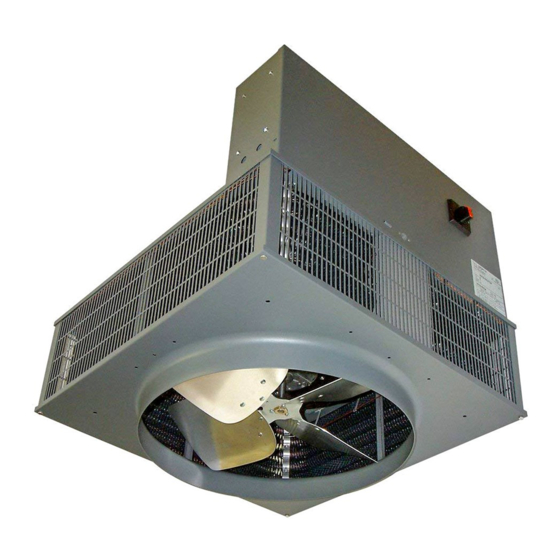
Advertisement
CHECK HEATER VOLTAGE AND PHASE ON DATA LABEL ON CONTROL PANEL DOOR TO MAKE SURE
THEY ARE THE SAME AS THE ELECTRIC SERVICE SUPPLY.
INSTALL SO THAT CENTERLINE OF HEATER IS NO CLOSER THAN 48" TO ADJACENT WALLS AND TOP
OF HEATING ELEMENT ENCLOSURE IS NO CLOSER THAN 15 1/2" TO CEILING (FACTORY SUPPLIED
MOUNTING BRACKET WILL MAINTAIN CORRECT DISTANCE TO CEILING).
NOTE: Wiring diagrams of the heaters and supply connections are permanently attached to the inside of the
heater power wiring enclosure. All terminals are coded in accordance with the wiring diagram.
INSTALLATION INSTRUCTIONS
Heaters may be mounted using factory supplied accessory mounting equipment or using special facilities
supplied by user.
NOTE: Only one heater may be controlled by a thermostat.
Wiring instructions, where required for remote controls are packed with each individual control. See wiring
diagram on heater access panel for wiring to heater.
After installation is complete, depress RED reset button(s) to insure continuity before applying power to unit.
OPERATION
Upon a call for heat from the floor level accessory thermostat, the unit fan motor and the heating element(s)
shall be energized and remain so until the temperature reaches the setting of the thermostat; at which time,
the heating element(s) shall be d-energized. The fan motor shall continue to run and purge the heater casing
of residual heat until the setting of the fan override is reached, then the fan motor shall be d-energized. For
those units available with sub-divided circuits, the floor level accessory 2 stage thermostat will upon a call for
heat energize the fan motor and the first stage heating element. Should the temperature continue to fall, the
thermostat shall energize the second stage heating element. Upon a rise in space conditions towards the setting
of the thermostat, the two stages of heating elements shall be d-energized in sequence. The fan motor shall
continue to run and purge the heater casing of residual heat until the setting of the fan override is reached, then
the fan motor shall be d-energized.
INSTALLATION INSTRUCTIONS
2600 SERIES DOWNFLOW HEATER
1.
Mount heater securely in the desired location.
2.
Remove desired knockout(s) on side of control panel.
3.
Open control panel cover at top of heater by loosening two screws, opening
latch, and turning disconnect handle to off position.
4.
Following wiring diagram, connect power supply in accordance with local and/
or national codes. Be sure heater is properly grounded using grounding lug
provided. Floor level thermostat control may be either low or line voltage
depending on individual heater control voltage, check heater data plate
before thermostat installation.
1
REV 05/14 ECO 1-6953 FORM: 8932
Advertisement
Table of Contents

Summary of Contents for TPI 2600 Series
- Page 1 INSTALLATION INSTRUCTIONS 2600 SERIES DOWNFLOW HEATER CHECK HEATER VOLTAGE AND PHASE ON DATA LABEL ON CONTROL PANEL DOOR TO MAKE SURE THEY ARE THE SAME AS THE ELECTRIC SERVICE SUPPLY. INSTALL SO THAT CENTERLINE OF HEATER IS NO CLOSER THAN 48” TO ADJACENT WALLS AND TOP OF HEATING ELEMENT ENCLOSURE IS NO CLOSER THAN 15 1/2”...
- Page 2 OPERATION CONTINUED The manual reset safety high limit shall d-energize the heating element(s) and/or control circuit should the temperature exceed the setting of this device. The fan safety override shall energize the fan motor any time the setting of this device is exceeded so as to purge the heater casing of excess residual heat.
- Page 3 IMPORTANT INSTRUCTIONS When using electrical appliances, basic precautions should always be followed to reduce the risk of fire, electrical shock, and injury to persons, including the following: 1. Read all instructions before using this heater. 2. CAUTION: High temperatures. Keep cords and all other combustible material, such as furniture, papers, clothes and curtains away from the heater.














Need help?
Do you have a question about the 2600 Series and is the answer not in the manual?
Questions and answers